Changing Widgets
Wordpress allows you to change the design and look of your page. There are several ways in which this is done. The most obvious way to affect your design is to change the Theme you are using. You can also add Widgets which are small pieces of code to add sections to the sidebars of your site.
Widgets
A Widget is a bit of text, a calendar, some links to other sites or other general stuff that you include in your blog that aren't blog posts or pages themselves.
By default Wordpress adds some widgets for you. If you haven't changed your theme you might see the following things in your second column.

The sections about Pages, Archive, Categories etc, are all your default Widgets. When you add your first Widget these default ones dissappear.
To add widgets to your Wordpress blog you must be using a theme which has at least one column, as this is where widgets live. This tutorial outlines how to use widgets on a theme with 2 columns. If you chose a theme with 3 columns then things get a bit more tricky.
Adding a Simple Widget
From your Dashboard select the Appearance link.
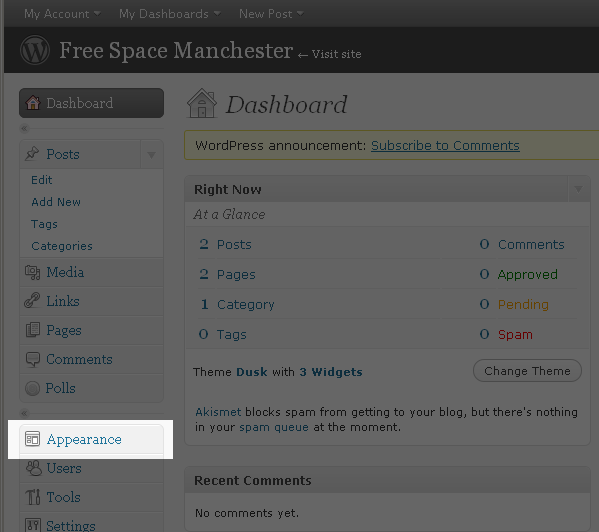
Then click on the link named "Widget".

You will see a list of available Widgets on the left of the page (see below).
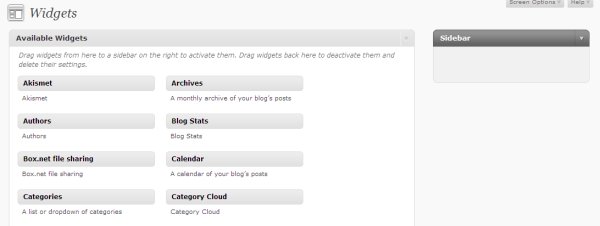
On the right, the darker column Sidebar represents the different element that you will see in your side column. You need to drag and drop different widgets to this sidebar. When they appear in the list the changes to your layout have been made. You should view the front end of the site to see if you are happy with them.
This set up is dependent on the theme you use. In this case we are using a theme with two columns. If you use a three column theme you may see a different arrangement.
Some useful Widgets
One of the more simple widgets you can add is the Pages Widget. This will display a list of the Pages that you have created for your blog in the second column.
Links are a vital widget to add if you have been using the default Wordpress system to add links (see other chapter).
The Flickr and Twitter plugins are useful if you use those services. And if you use Categories for your posts then you should make sure that that Widget gets included too. A sample setting for Twitter is shown below.

Below, you can see a sample list of widgets in a Sidebar.

There is a really good resources page on Wordpress.com which lists different Widgets and what they do, which can be accessed if you click on the Help tab on the top right of the page.
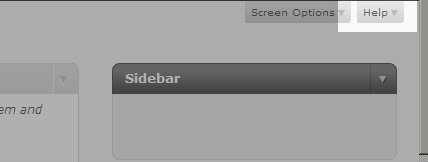
Promote your Podcast Widget
You can get tricky with your widgets, we will try sometting a little more advanced. A more advanced use of a Widget could be to include an Image which links to your RSS feed. This is especially useful if you are linking to media files, as it will act as your podcast subscribe button. To do this you would add a Text Widget.
The Text Widget is very flexible and allows you to add text and HTML code to your sidebar.
This is very useful as it allows you to add a HTML text like a link to an image. We will use it to add a link to your Podcast in the form of an image.
To do this you should do the following.
Click on "Add" next to "Text" on the Widgets page.

Find an image which represents your podcast. For example I did a search for "RSS icon" and selected the following.

You need to know the URL of this image, in this case it is : 'http://hartstoneideas.com/rss-img.jpg'
Click on "Edit" next to the "Text" link that has appeared on the right of your Widgets screen.
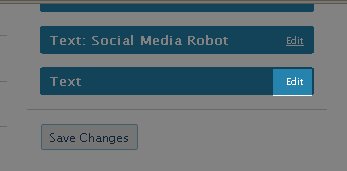
Next add the image to the Text Widget by entering the following code
<img src ="http://hartstoneideas.com/rss-img.jpg">
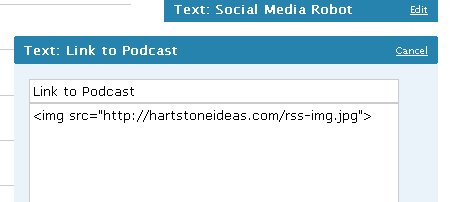
Then you should make that image into a link. You can do that by adding the following code around the code for the image.
<a href="http://moorsideradio.wordpress.com/rss"> <img src ="http://hartstoneideas.com/rss-img.jpg"> </a>

You will notice that the link is to your Wordpress RSS feed - this is used by players like iTunes or Songbird to download and play the file.
Then your RSS feed will be : "http://moorsideradio.wordpress.com/rss
That is all you have to do. Now publish the entry and check it in your browser. If you click on the image link you should be directed to the RSS Feed which may look something like this :






